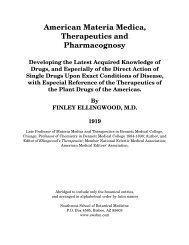SCARLET FEVER. Synonyms.—Scarlatina; Scarlet Rash. Definition ...
SCARLET FEVER. Synonyms.—Scarlatina; Scarlet Rash. Definition ...
SCARLET FEVER. Synonyms.—Scarlatina; Scarlet Rash. Definition ...
You also want an ePaper? Increase the reach of your titles
YUMPU automatically turns print PDFs into web optimized ePapers that Google loves.
colonies appear on the culture medium in the form of thin, grayish<br />
masses of scales.<br />
Its vital tenacity is also characteristic, and, whether inside or outside the<br />
body, has great resisting power. These bacilli survive freezing and<br />
desiccation, and live indefinitely outside the body. In the body they are<br />
found in all tubercular masses, though in varying quantity, the greatest<br />
numbers being found in actively forming tubercle. Should a tubercular<br />
mass open into a vein or lymph tract, they will be found distributed to<br />
every tissue of the body.<br />
Outside the body they are found principally in the sputum. Nuttall has<br />
estimated that several billion are thrown off daily by a phthisical<br />
patient during the advanced stage. The sputum drying, is reduced to<br />
dust by the friction that is constantly going on, and this dust permeates<br />
the atmosphere everywhere, settles upon furniture, draperies, carpets,<br />
the bed-linen, in fact, upon every article in the home of the afflicted, as<br />
well as upon walls and ceilings. When this dust is dislodged, it again<br />
floats in the air and is even then a source of danger.<br />
The bacillus may be found in quite large numbers in the nares of people<br />
occupying or visiting these infected quarters. The chemical products<br />
resulting from the evolution of the bacillus and infected tissue has not<br />
yet been determined.<br />
Mode of Infection.—The most frequent manner of receiving the<br />
infectious material is, undoubtedly, through respiration, and the minute<br />
bronchial tubes and lung are the first to show its ravages, although the<br />
nares and larynx follow in quick succession. At other times it gains<br />
entrance through the digestive apparatus, through infected meat and<br />
milk. Hereditary transmission, while possible (tubercles having been<br />
found in the fetus), is extremely rare and is mosr likely transmitted<br />
through the blood bv way of the placenta. Inoculation may occur, by<br />
coming in direct contact, through cuts, fissures, excoriations, abrasions<br />
of any character, and generally assumes the character of tuberculosis of<br />
the skin.<br />
Pathology.—Any organ of the body may be the seat of the disease,<br />
though some special parts are peculiarly susceptible. In the adult the<br />
lungs are the most frequently affected, while in children the lymph<br />
glands, joints, and intestines are the seat of election. The brain is also<br />
quite often the seat of the lesion, while the other viscera, liver, kidneys,<br />
The Eclectic Practice of Medicine - PART I - Infectious Diseases - Page 182

















